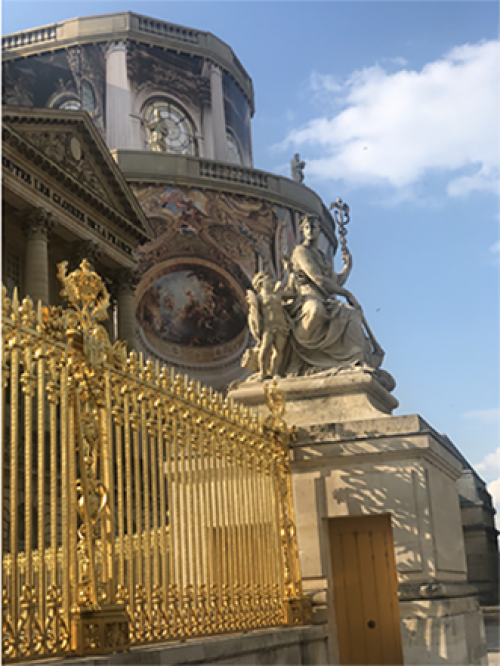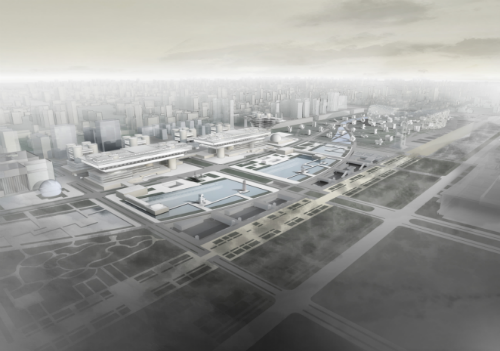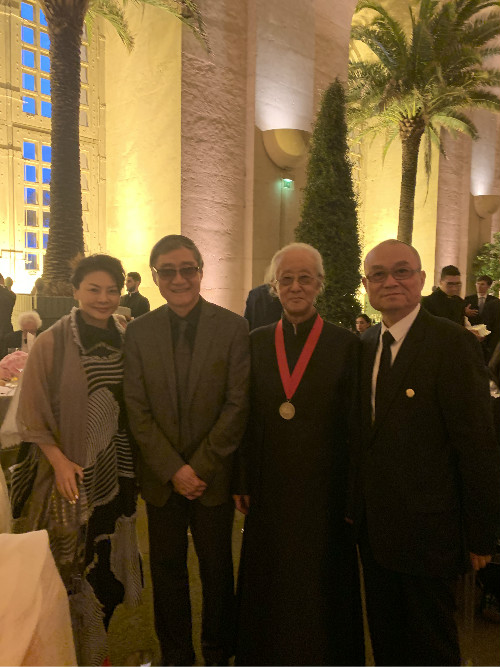
2019-05-27
在凡尔赛宫的满脸皱纹下,修剪整齐的植物在春的召唤下魂回空气,各种颜色的酒透过水晶杯的反射点缀出明星云集的璀璨,杯声伴奏出小鸟的叽叽喳喳,碰撞出思想的火花,各式当红竭力透出点肉色般迷人的风骚,勾引出奋斗前行的欲望。我想这便是颁奖与得奖的积极意义。

一个88岁的人,一定是经历过无数风景奇观,懂得事物的本质意义,今天才步入凡尔赛达成颁与受的约定,其目的在于承前启后。
两个月前在巴黎呆了十几天,骑着滑板车穿行于大街小巷,亲临奥斯曼时期的建筑,仿佛听到点什么在脑际萦绕。回北京的两天后就得知矶崎新获奖的消息,于是我就写了“在矶崎新获普利兹克奖时”。今天是矶崎新接受颁奖的日子,又是在凡尔赛宫,于是我又想起矶崎新8年前在中国美术馆新馆投标时的问:
你到底是要系统,还是要形象?
其实编写设计任务书的主旨是在要系统,如果是要形象就不会写城市设计导则的篇章,因为当时我们这一群组织招标文件编写与审核的伙伴们,已经在反思城市形象时尚化、明星化的问题。然而在实际行动过程之中,却没能控制住行为又站在了形象至上的立场。好在这本铁证如山的文字阐明了我们的主张。投标入围的人都多多少少回应了系统的问题,我们又在比对谁更切中中文立意上的形象做出了选择。当矶崎新在漫不经心地发问时,还没有发力就已经出局了。这样的擦肩而过也是缘分,是在上下文的情景之中,没有对与错。
当在巴黎的街道穿行时,我记得的是奥斯曼这个"规划师"、"建筑师"而不是拿破仑三世,这可能是绝大多数人的共识。巴黎这座城市因奥斯曼而具备了影响力,但不知在那个时代又有多少地主、资本家仇恨着他呢,奥斯曼就是兑现集约化意识的典型代表。人类的历史一直在依赖于公约数形成的制度推动着发展,当这一制度约束了人的创新力和进步时,就松绑一下、革新一下,“白猫黑猫,抓住老鼠就是好猫”、“发展是硬道理”就是松绑的产物。当人欲膨胀到一定程度,总归还得靠大数据形成的经验制度来控制你,也就是今天收敛。
矶崎新用梁思成来破题发问,针对的是城市建设的又一次变革,你们如何吸取过去的经验与教训,你们做好了准备没有。梁思成站在新中国建立的那一时期,提出了保护旧城、异地建新城的规划,完全是在系统的立场上考虑问题,是符合当时五年计划集中建设的政策导向的。但毛泽东更需要的是确立中国在世界的地位,抗美援朝显然重于城市建设。身处贫困经济状况下的领袖们,选择旧城的拆拆补补,我想这是当时的必然选择,并不是几十年后评价的对文化遗产的轻视,对古都的人为毁弃。针对1950年代的中国社会、中国人、中国经济等各种因素错综复杂的交织,放弃梁思成的建议是实事求是的做法,然而今人的惋惜凝聚成教训,对而今的再一轮城市变革也是有积极意义的,因为我们初步具备了传承文脉的条件。我想矶崎新的发问恰是警惕,因为市场经济促进资本自由生长、个性突出的实践正吞噬着系统平衡、缩小差距的理念。事实上8年前我们的行为仍没有挣脱出景观、时尚、明星的轨道,虽然嘴里喊着要系统。然而在那一段时期,我几次与矶崎新交流或者听他的讲演,他都在强调系统、文脉。此时此刻,人的活动的问题,这可能是矶崎新对我的再启蒙。


2003年央美美术馆筹建之时,我在东京他的工作室,他问我们:是要经典意义的美术馆还是要现代意义的美术馆、展览会意义的美术馆、研究意义的美术馆……。我们的回答是都要。后来见识多了,反省自己当时的言论,其实是什么都没有回答。就拿研究意义的美术馆为例,我完全停留在字面意义对研究的理解,其实研究意义的馆,是要美术馆开放后台,把后台与前台的边界打通,让研究的行为也成为可视的内容,例如:如何修复、如何整理档案、如何做标本等等。我的无知获得了矶崎新的谅解与理解,他了解到我们没有这个条件实现研究意义的美术馆,于是按他的认识和我们切实的需要,引导我们完成了美术馆的设计。回忆当年的交流,作为骄傲自满的甲方代表,深感羞愧,这应该是早期的启蒙。
突然,项目经理老顾向我告急:谢主任,图纸出了错误,主入口没有设台阶,水会漫进来;厕所地面没有低下去,如果下水管堵了,污水会流出来,通常我们的做法都是要台阶低一槛。我问怎么办,老顾说只有砸掉重浇。我心想这么大的大牌,怎么会出这样的低级错误。于是马上与矶崎新对话,心生怨气,这回终于抓住把柄治一下胡倩的伶牙俐齿。老矶回答的语气平缓如丝:你如果下水管都理不通,那还做什么美术馆呢,美术馆是现代文明的产物。意思是你又不是在农村的宅基地上建房子。我愣住了,是这个道理呀。结果一查图纸,美术馆地面都没有门槛,都在一个平面上,为了给运输文物的小推车消除障碍,为了给残疾人的轮椅提供便捷。恍然大悟!太和殿的高台阶是权威,美术馆的无台阶是亲和。正是因为我们大多数人的习惯,在国内的设计院画施工图时,仍在基础订标高时留下了台阶,等房子竣工时,才发现主入口预留了三步台阶。于是我坚决兑现矶崎新启蒙的成果,用土石填平了这坑。亲和、平易就这样达成了。
当潘公凯亲眼看了奈良百年会馆时就完全相信了老矶。这三片弧构成的壳体如何实现在我的心中也是踏实的,因为大师包治百病。在具体如何实现时有混凝土壳体的路径,可是异型模板从哪里找,代价是巨大的,何况三块混凝土壳体交汇的天光处一定会往下塌,必须加柱子支撑,一加柱子,大空间就丢失了,显然弃明投暗。第二条路是做钢结构,用钢板蒙上去,像造船一样。于是我带着矶崎新的助手青木宏找到了江南造船厂咨询。不问不知道,一问吓一跳,卡壳了。这时老潘说钢板一定是焊接,建房子不可能像造船、造锅炉一样焊,焊点漏水那就麻烦了,锈蚀也不能解决,必须考虑结构防水。他说:中国的坡屋顶好就好在排水畅通。讲了一段他的经历给我听:潘天寿纪念馆是民国时期的建筑,屋顶漏水。平屋顶漏水是现代建筑的通病,翻修了很多次还是漏,大家找不到漏点,于是他就把屋顶灌了一池水,然后把墨水倒点进去,墨水流向的地方就是漏点。这一脑筋急转弯让我见识了老潘的功力。我把这故事讲给了胡倩听,她惊了。正在一头雾水时,大剧院屋顶的例证启发了我们,才找到了解决问题的办法。现在想起来,其实解决的路千条万条,只是你敢不敢或有没有钞票拿做宇宙飞船的钱来造房子,万事只有一个平衡点,谁碰上谁就是幸运儿。然而老矶与老潘彼此信任促进了我们这群吵吵闹闹的小鬼儿不断前行,可谓峥嵘岁月。
今天,普利兹克组委会让矶崎新邀请他的朋友去凡尔赛宫见证颁奖这一时刻,名额极其有限。请谁?矶崎新说了句名言,这次颁奖是颁给他的客户,所以,88岁的老矶选了西班牙前国王、卡塔尔前国王、埃及前文化部长,然而中国这一个名额请谁?老矶断然认定是潘公凯。他说:我请的客人,全是支持我、肯定我的业主,并非在位的官员,潘公凯是在中国所有项目中坚定支持我的唯一一位。
正是这种信任与支持,才实现了“建筑是集体”的理念。幸运的是电脑上、图纸中、混凝土浇注、钢结构焊接的所有人都各自维护了集体这个概念,这不得不说是美术馆这座房子的幸运,因为房子比人活得更长。


“小凡,我们在此之中共同成长。”胡倩在3月10日读了我的文章后对我说。我想这“之中”指的就是“集体”,如果有第二层意义的话,那就是“做”,这是我最大的获益。当年进入这行当时,胡倩是日本早稻田大学的科班硕士、老矶的助手,我还是一个门外汉,起点不知道低多少,还多次仗着甲方的势欺负胡倩,真是惭愧。只是因为在这“做”的过程中,不耻下问,又遇上这么多的好老师、好师傅,才使我有了今天的见识,工地是我的大学。在今天颁奖给矶崎新这个时刻,禁不住让我想起了过去的许多事,谨此作为对矶崎新的敬意,并祝福老先生平和长命。
谢小凡
Upon Arata Isozaki Receiving the Award
Beneath all the wrinkles of the Château de Versailles, the carefully trimmed plants are getting their soul back in air as spring calls. Through the refraction of the crystal glassess, wines of different colours embellish a dazzling gathering of stars, as if accompanying the twittering of birds and sparkling intellectual thoughts as the glasses tinkle. Celebrities of all kinds spare no efforts to play a touch of enchanting coquette, seducing the desire to strive forward. I think this is exactly the positive meaning of granting and becoming laureate of the prize.
An 88 year old man, he must have gone through countless landscapes and wonders, and understood the essence of things, before he presents himself today at the Versailles, a site of conferring and receiving a prize, the significance of which is bridging the past and the future.
Two months ago, I spent a dozen days in Paris, riding a scooter in her streets amongst the buildings of the Haussmann period, and seemed to have heard something that lingered in my mind. Two days after I returned to Beijing, I learned the news of Arata Isozaki becoming the laureate of the award. Today is the day the prize is presented to Arata Isozaki, again at Paris, and it came to my mind the question he asked us when submitting a tender for the new NAMOC eight years ago:
What do you want exactly? A system or an icon?
When I was wandering in the streets of Paris, what I remembered was Haussmann, the “architect” and “urban planner”, rather than Napoleon III. The city of Paris, Haussmann has made her more charming, but at his time no one knows how many landlords and capitalists hated him, because he was the utmost embodiment of concentrated urban development. Human history relies on public contracts to formulate the system, and when a system constrains human innovation and progress, there would come unloosening and renovation. The notions like “it doesn't matter whether a cat is black or white as long as it catches mice” and “development is the hard principle” are the outcome of loosening. Arata Isozaki quoted Liang Sicheng to open an issue and raise a question, in the context of another transformation in urban construction: how have you learned from past experiences and lessons, and, are you fully prepared?
Liang Sicheng’s plan to protect old Beijing and build a new city elsewhere at the founding years of new China, was entirely an option from the perspective of the system, and was in line with the policy orientation of concentrated construction in the First Five-Year Plan. However, what Mao Zedong needed more then was to secure China's position in the world, and the War to Resist America and Aid Korea apparently took precedence over urban construction. With limited materials and resources, I think it was natural that Chines leaders chose to patch and mend on the old city. Decades later, this decision was seen by some as a contempt to cultural heritage which caused the destruction of the old capital, but that criticism does not get into the context of that time. Taking into account the entangled and complex interaction among various factors involving the Chinese society, Chinese people and Chinese economy in the 1950s, it was a realistic and practical choice to give up Liang Sicheng’s proposal. However, the sorrows felt by people today has become a lesson and would play a positive role in the on-going new round of urban transformation, for the conditions for carrying on the cultural lineage are now available.
I think Arata Isozaki’s question was nothing short of an alert, that a market economy which promotes the free growth of capital and highlights individuality is engulfing the idea of system balance and narrowing gap. As a matter of fact, what we did eight years ago was unable to break away from the track of landscape, trends, and stars, although we shouted for a system. However, in the talks with him and in his presentations at that time, Arata Isozaki always stressed the system and the cultural lineage. When I visited him in Tokyo in 2003, in preparation for the construction of CAFA Art Museum, he asked: what do you want, an art museum of the classic sense, an art museum of the contemporary sense, a curating-centered art museum or a research-centered art museum...? Our answer was we wanted it all. As my perceptions grew, I started to reflect on my words on that day and realized my answer meant nothing. Arata Isozaki tolerated our ignorance, and eventually got to know that what we really wanted was to make his design workable. That is his patience and his capability.
Pan Gongkai placed full trust in Arata Isozaki once he saw the Nara Centennial Hall with his eyes, and I felt assured too that the shell of three arcs was achievable at CAFA Art Museum. Despite, of course, the many difficulties and barriers emerged during the construction process, I believe that everything has a equilibrium point and whoever encounters it is the lucky one. I believe also that efforts make success. The mutual trust between Arata Isozaki and Pan Gongkai has led to the progress of we the noisy lads - what memorable years!
Today, the Pritzker Committee allows Arata Isozaki to invite his friends to the Versailles as witnesses to the presentation ceremony, but the number is very limited. Who would he invite? Arata Isozaki said a bon mot: the prize is presented to my clients. Thus the 88-year-old architect has invited the former King of Spain, the former Emir of Qatar, and the former Minister of Culture of Egypt. But who would he invite from China? Arata Isozaki made his decision without hesitation that it would be Pan Gongkai. He said: the guests I invite are all clients who have supported and acknowledged me, not incumbent officials; and Pan Gongkai is the only one who supports me most firmly of all my projects in China.
It is this trust and support which has brought to life the idea of architecture being collective. Fortunately, everyone in the project, either working with the computer, with the drawings, with concrete casting, or with steel structure welding, has worked to maintain this “collective”. This, one must say, is the luck of CAFA art museum as a building, because a building outlives people. Today, at the very moment the award is presented to Arata Isozaki, I could not help recalling the many scenes from the past, and would pay homage to Arata Isozaki with this essay and wish him longevity and peace in life.
Xie Xiaofan
谢小凡:中国国家画院副院长。曾在中国美术馆做副馆长承担新馆建设工作。策划过一系列大型展览。著有《展览美术馆》、《辨象——行走于艺术与建造之间》,承担编写(国颁)《公共美术馆建设标准》,曾主持中央美术学院美术馆建设,与矶崎新、潘公凯、胡倩(矶崎新建筑事务所合伙火)合作。
